Sun Gate
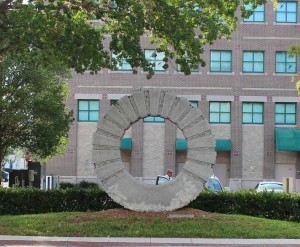 Standing 12 foot tall and across, the circular granite sculpture named Sun Gate greets commuters entering and departing the River District via Main Street. Located half a block west of Main’s intersection with Monroe Street, Sun Gate is framed on either side by concrete park benches and nestled between the Lee County Community Development building to the north and the Lee County Justice Center to the south. It was the quest of c
Standing 12 foot tall and across, the circular granite sculpture named Sun Gate greets commuters entering and departing the River District via Main Street. Located half a block west of Main’s intersection with Monroe Street, Sun Gate is framed on either side by concrete park benches and nestled between the Lee County Community Development building to the north and the Lee County Justice Center to the south. It was the quest of c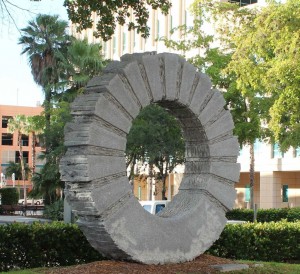 reator Robert Sindorf to “carve large granite sculptures for public places … [that] express universal and timeless themes.”
reator Robert Sindorf to “carve large granite sculptures for public places … [that] express universal and timeless themes.”
Virtually all of Sindorf’s sculptures incorporate a circle as their primary geometrical shape. “It is perfect geometry and has no beginning or end,” Sindorf stated. “It is a peaceful, restful form that transcends time and becomes eternal. It is a symbol of the sun, heaven, perfection and, especially, the cycle of life.” Which explains why Sun Gate also 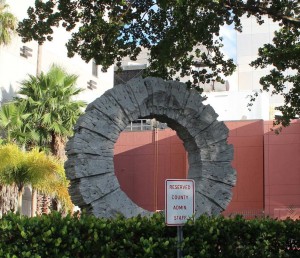 goes by the name “Wheel of Life.”
goes by the name “Wheel of Life.”
The sculpture’s location is problematic. First, Sindorf intended Sun Gate to be viewed from the north, meaning that commuters and pedestrians passing by on Main Street are actually looking at the sculpture’s backside. (In fact, the lower portion of the side most people see is less refined and virtually unfinished.) Few people venture into the Community Development employee parking lot to look at 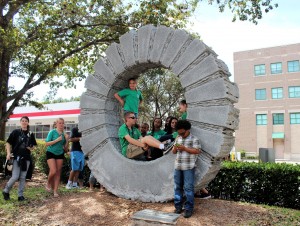 the front of the sculpture, but even if they did, they would find their view obscured by parking curbs, signs and a 4-foot hedge.
the front of the sculpture, but even if they did, they would find their view obscured by parking curbs, signs and a 4-foot hedge.
Secondly, Sindorf wanted people to be able to pass through the hole in Sun Gate both visually and physically. “The void allows you to move through the sculpture,” Sindorf observed. “You are not blocked physically or figuratively if there is a ‘hole’ through it. 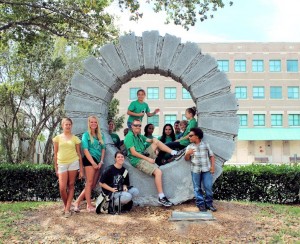 You can physically ‘enter’ the work. This geometry helps you move through the sculpture. We are all accustomed to moving through geometrical shapes like houses and larger buildings. Big sculptures with voids seem architectural and make you feel that you are part of them and not just a spectator.”
You can physically ‘enter’ the work. This geometry helps you move through the sculpture. We are all accustomed to moving through geometrical shapes like houses and larger buildings. Big sculptures with voids seem architectural and make you feel that you are part of them and not just a spectator.”
Public artists frequently incorporate interactive components into their artwork in an effort to encourage viewers to relate to 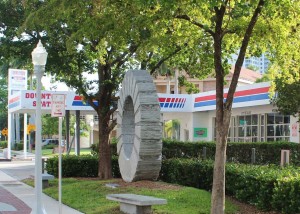 the piece in a pro-active, experiential manner. For example, sculptor David Black designed Fire Dance (in Centennial Park) so that people can walk through it and look up. “Inside the piece are four hidden spirals that create a story for your imagination,” Black told the crowd who gathered for Fire Dance’s March 2, 2012 dedication and ribbon cutting ceremony. “I like the idea of letting
the piece in a pro-active, experiential manner. For example, sculptor David Black designed Fire Dance (in Centennial Park) so that people can walk through it and look up. “Inside the piece are four hidden spirals that create a story for your imagination,” Black told the crowd who gathered for Fire Dance’s March 2, 2012 dedication and ribbon cutting ceremony. “I like the idea of letting 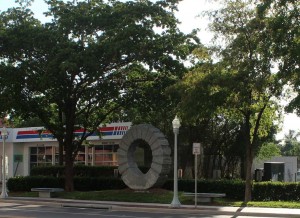 people walk around the sculpture and see it from underneath. I want them to enjoy the piece from every angle.” Similarly, people encountering the art panels on the Justice Center parking garage (Parallel Park) can change their appreciation and enjoyment of artist Marylyn Dintenfass’ abstract images by moving closer or farther away, or otherwise changing their perspective or viewing point.
people walk around the sculpture and see it from underneath. I want them to enjoy the piece from every angle.” Similarly, people encountering the art panels on the Justice Center parking garage (Parallel Park) can change their appreciation and enjoyment of artist Marylyn Dintenfass’ abstract images by moving closer or farther away, or otherwise changing their perspective or viewing point.
B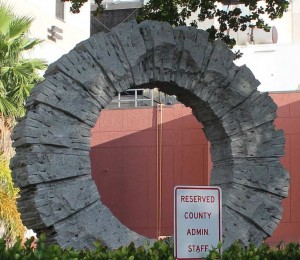 ut perhaps the biggest drawback associated with the sculpture’s current location is that is detracts from the overall impact of the piece. “The void space is more important and potent than the surrounding solid. Defining a negative space is not always appreciated as sculptural, but like architectural space, it can hold the most important meaning of the work.”
ut perhaps the biggest drawback associated with the sculpture’s current location is that is detracts from the overall impact of the piece. “The void space is more important and potent than the surrounding solid. Defining a negative space is not always appreciated as sculptural, but like architectural space, it can hold the most important meaning of the work.”
A Word about Robert Sindorf
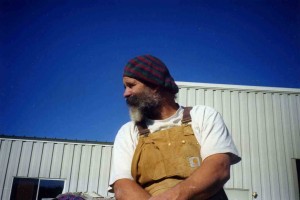 Robert Sindorf was born in Amsterdam on December 8, 1951. Robert Sindorf died unexpectedly on December 22, 2008 at the age of 57. He is survived by his wife, Gabby, and four children, Derrick, Lloyd, Hannah, and Owen.
Robert Sindorf was born in Amsterdam on December 8, 1951. Robert Sindorf died unexpectedly on December 22, 2008 at the age of 57. He is survived by his wife, Gabby, and four children, Derrick, Lloyd, Hannah, and Owen.
Sindorf’s family immigrated to the United States when Robert was five, and Bob grew up in Little Falls, New Jersey. He 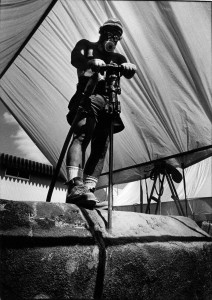 obtained his Bachelor of Arts degree in art history and philosophy from Columbia University, where he also obtained a Masters of Architecture in 1977. Although Sindorf worked eight years in the field as a project designer, his true love was monumental sculpture.
obtained his Bachelor of Arts degree in art history and philosophy from Columbia University, where he also obtained a Masters of Architecture in 1977. Although Sindorf worked eight years in the field as a project designer, his true love was monumental sculpture.
“Probably the turning point that led me down the path of madness to a career in sculpture was my first visit to [Minoru Niizuma’s] loft studio on 168th Street in Manhattan,” Bob once said. “All the space, stone, materials, dust and chaos turned my head to the alternate lifestyle that he lived.” As the Japanese abstract sculptor’s apprentice, Sindorf became imbued with Niizuma’s love of marble, granite, volcanic 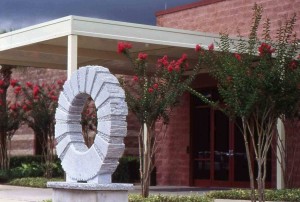 rock and other materials and the master’s affinity for geometric forms and organic designs that blended Asian tradition with contemporary western art.
rock and other materials and the master’s affinity for geometric forms and organic designs that blended Asian tradition with contemporary western art.
“[But] to say I chose sculpture is not really true,” Sindorf insisted. “I feel I had no choice but to work in stone. I don’t know if it’s a passion. Today, I think it’s just something I must 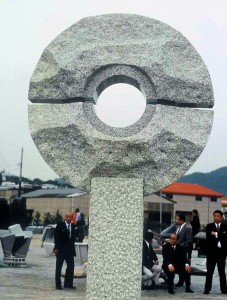 do. There exists an endless possibility of shapes, colors, textures and possibilities with stone that I have only one lifetime to explore. I certainly have enough stone but not enough time left,” he said prophetically. “My studio is filled with drawings and models of works that soon will ‘be, given the freedom and time to make them real. I draw so as not to forget the ideas that come up daily.”
do. There exists an endless possibility of shapes, colors, textures and possibilities with stone that I have only one lifetime to explore. I certainly have enough stone but not enough time left,” he said prophetically. “My studio is filled with drawings and models of works that soon will ‘be, given the freedom and time to make them real. I draw so as not to forget the ideas that come up daily.”
Between 1984 and 2008, Sindorf completed 25 public commissions, including one in Canada, another in Portugal and eight in Japan (many of which were produced during Sindorf’s 6-month residency as the recipient of a Japanese Foundation Fellowship in Sculpture). 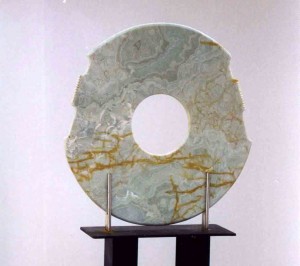 Each of Sindorf’s monumental sculptures is granite, ranges in height from 8 to 80 feet, and resulted from winning either a national or international competition. For example, his design at the University of West Florida was chosen over 500 other submissions.
Each of Sindorf’s monumental sculptures is granite, ranges in height from 8 to 80 feet, and resulted from winning either a national or international competition. For example, his design at the University of West Florida was chosen over 500 other submissions.
In addition to Sun Gate, Sindorf was responsible for several sculpture installations located throughout Florida, including Touch the Sky in front of the New Engineering Building at the University of Florida (1998), 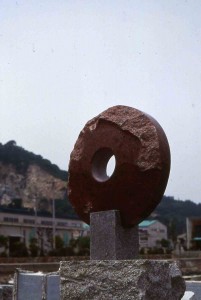 Nautilus Freed in front of the Health, Leisure and Sports Facility at the University of West Florida, which symbolizes the act of becoming through higher education (2005, right), and Gate of the Sun in front of the Student Services Building at Florida A&M University in Tallahassee (2005).
Nautilus Freed in front of the Health, Leisure and Sports Facility at the University of West Florida, which symbolizes the act of becoming through higher education (2005, right), and Gate of the Sun in front of the Student Services Building at Florida A&M University in Tallahassee (2005).
His 2003 installation Gate of Heaven for the Department of Transportation in Deland (left) looks almost identical to Fort Myers’ Sun Gate.
Sindorf also carved small intimate works in marble, granite and onyx, which he exhibited worldwide. He also taught sculpture at a number of venues both as a visiting artist and artist in residency.
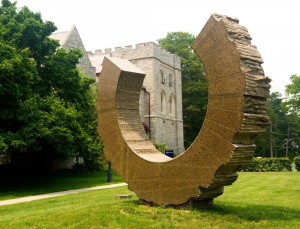 His sculpture followed a fixed sequence that involved cutting, carving, polishing and installing. Large saws, polishing equipment and heavy forklifts were all part of the tools of Sindorf’s trade. “It is like a journey of discovery for me as I work, struggle, at times, with the essence of the stone. I strive to maintain the rugged strength of the material while still adding a human touch. As Noguchi once wrote concerning this same process: ‘A
His sculpture followed a fixed sequence that involved cutting, carving, polishing and installing. Large saws, polishing equipment and heavy forklifts were all part of the tools of Sindorf’s trade. “It is like a journey of discovery for me as I work, struggle, at times, with the essence of the stone. I strive to maintain the rugged strength of the material while still adding a human touch. As Noguchi once wrote concerning this same process: ‘A 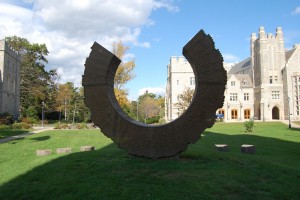 dialogue ensues of chance, no chance; mistakes, no mistakes. No erasing is possible or reproduction; at least not in the way I now work, leaving nature’s mark. It is unique and final.’ I view this process in the same way.”
dialogue ensues of chance, no chance; mistakes, no mistakes. No erasing is possible or reproduction; at least not in the way I now work, leaving nature’s mark. It is unique and final.’ I view this process in the same way.”
Sindorf took great pains to leave the impression of nature’s touch in his completed work. “The stone itself 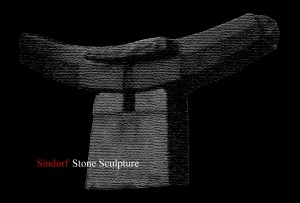 is rough and worked by time, yet the finished piece reveals the contrast from the effects of my hand,” Sindorf explained. “As a sculptor, I form the piece but do not overcome it. I try to know when to stop.”
is rough and worked by time, yet the finished piece reveals the contrast from the effects of my hand,” Sindorf explained. “As a sculptor, I form the piece but do not overcome it. I try to know when to stop.”
Not surprisingly, the sculptor described his style as minimal and abstract. “I endeavor to reduce an overall image to its most 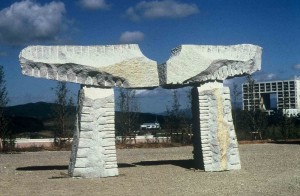 essential form. My style is suggestive rather than overt. I work with what nature has imbued the stone. There is no forced manipulation, but rather a flow, like a river.”
essential form. My style is suggestive rather than overt. I work with what nature has imbued the stone. There is no forced manipulation, but rather a flow, like a river.”
Location and Measurements.
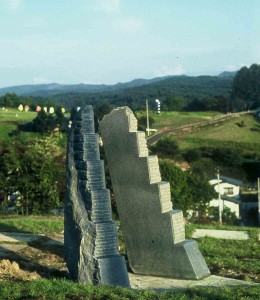 Sun Gate’s street address is 2081 Main Street, Fort Myers, FL 33901
Sun Gate’s street address is 2081 Main Street, Fort Myers, FL 33901- Its coordinates are longitude 26° 38′ 31.4556″ N and latitude 81° 52′ 16.788″ W.
- The sculpture has a diameter of 126 inches and a depth of 27 inches.
- The void or negative space in its center measures 72 inches in diameter, has a circumference of 226 inches and an area of a little more than 28 square feet.
Fast Facts.
- Sun Gate was installed in 1998.
- It is a county-owned public artwork.
- It was commissioned by the 8-member Art in Public Places Board established pursuant to the Lee County Art in Public Places Program (Ordinance 8-21, as amended by Ordinance 88-5). Sun Gate was the last commission under the program, which was sunset in 1999.
- Sindorf created many of his larger works at RMG Stone in Castleton, Vermont. His relationship with the stone factory started with his U.S. commission, Middle Path, for the University of Connecticut Law School in 1992, and remained with them until his death in 2008. “I owe them a great deal of gratitude for making all of this happen,” Sindorf notes.
 Some see a resemblance between Sun Gate and Star Gate, the portal featured in the 1994 feature film starring Kurt Russell and James Spader. But if the film influenced Sindorf in the creation of works like Sun Gate, Gate of Heaven in Deland or sister works, the sculptor never said.
Some see a resemblance between Sun Gate and Star Gate, the portal featured in the 1994 feature film starring Kurt Russell and James Spader. But if the film influenced Sindorf in the creation of works like Sun Gate, Gate of Heaven in Deland or sister works, the sculptor never said.














 Tom Hall is both an amateur artist and aspiring novelist who writes art quest thrillers. He is in the final stages of completing his debut novel titled "Art Detective," a story that fictionalizes the discovery of the fabled billion-dollar Impressionist collection of Parisian art dealer Josse Bernheim-Jeune, thought by many to have perished during World War II when the collection's hiding place, Castle de Rastignac in southern France, was destroyed by the Wehrmacht in reprisal for attacks made by members of the Resistance operating in the area. A former tax attorney, Tom holds a bachelor's degree as well as both a juris doctorate and masters of laws in taxation from the University of Florida. Tom lives in Estero, Florida with his fiancee, Connie, and their four cats.
Tom Hall is both an amateur artist and aspiring novelist who writes art quest thrillers. He is in the final stages of completing his debut novel titled "Art Detective," a story that fictionalizes the discovery of the fabled billion-dollar Impressionist collection of Parisian art dealer Josse Bernheim-Jeune, thought by many to have perished during World War II when the collection's hiding place, Castle de Rastignac in southern France, was destroyed by the Wehrmacht in reprisal for attacks made by members of the Resistance operating in the area. A former tax attorney, Tom holds a bachelor's degree as well as both a juris doctorate and masters of laws in taxation from the University of Florida. Tom lives in Estero, Florida with his fiancee, Connie, and their four cats.
Robert and I were childhood friends. We played music together.
Bob played a bass guitar that he had made himself.
His creative energy was evident, he was also an excellent athlete.
It appears to me that his early artistic and athletic sides came together in his chosen life work as a stone sculptor.